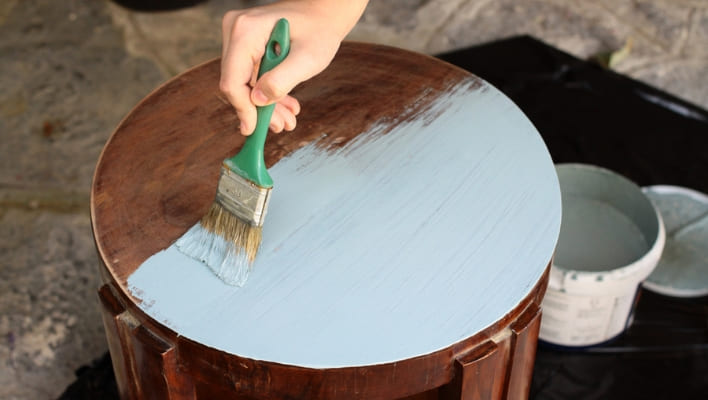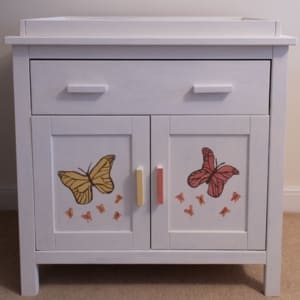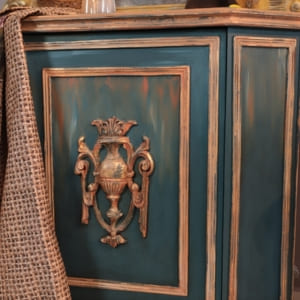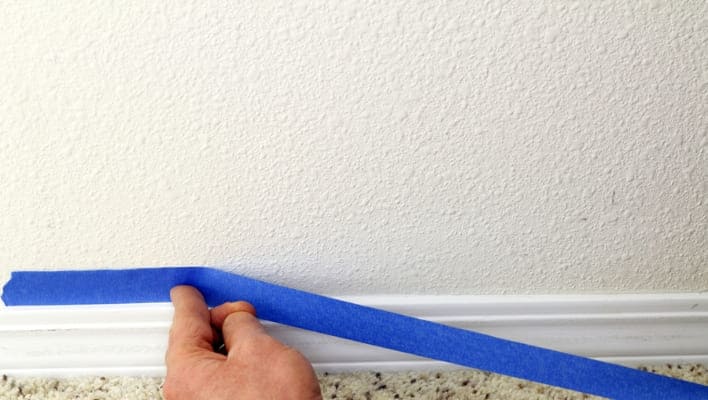Painting is an important aspect when you plan the renovation of your furniture. It not only rejuvenates the appearance of your cherished pieces but also offers an opportunity to express your creativity and style.
However, when it comes to furniture painting, a common concern arises about chalk paint vs regular paint: which one to choose?
Chalk paint is known for its matte, textured finish, requiring no prep work, making it ideal for rustic and distressed looks on furniture and decor. Regular paint offers various finishes, suitable for a broader range of surfaces like walls, ceilings, and trim, but typically requires more traditional application and may not need additional sealing.
So stay tuned to know more about using chalk paint versus regular paint for your furniture projects.

Table of Contents
- Chalk Paint vs Acrylic Paint
- Why Use Chalk Paint Vs Regular Paint?
- how is chalk paint different from regular paint?
- Primer and Surface Preparation: Chalk Paint Vs Regular Acrylic Paint
- Coverage and Thickness: Chalk Paint Vs Latex Acrylic Paint
- Consistency and Texture
- Finish Options
- Sealing and Durability: Chalk Paint Vs Acrylic Paint
- Drying Time: Chalk Paint Vs Acrylic Paint
- Chalk Paint Vs Regular Paint: Which One Is Best To Use On Distressed Furniture?
- Brush Marks on Furniture: Chalk Paint Vs Regular Paint
- Ideal Uses of Both Paints
- Wrapping Up
- FAQS On chalk Paint Vs Regular Paint (Acrylic)
- Q. Is it possible to substitute acrylic paint for chalk paint?
- Q. What makes chalk paint a preferred choice for crafters?
- Q. can you mix chalk paint with acrylic paint?
- Jennifer Marie
Chalk Paint vs Acrylic Paint
| Aspect | Chalk Paint | Regular Paint (Acrylic) |
| Composition | Water-based with calcium carbonate | Water-based with acrylic polymer |
| Surface Preparation | Minimal prep, often no primer needed | May require sanding and priming |
| Coverage | Excellent coverage, fewer coats needed | Good coverage but may require more coats |
| Consistency | Thick and textured | Variable consistencies, smooth to heavy |
| Finish Options | Matte or chalky finish | Wide range of finishes (satin, matte, gloss) |
| Sealing and Durability | Requires sealing for added durability | Durable finish, sealing optional |
| Drying Time | Quick drying time of 5 to 15 minutes, longer curing time of 24 hours to 2 weeks | Longer drying of 30 to 60 minutes, shorter curing time of 3 to 4 days |
| Distressed Furniture | Ideal for distressed looks | Requires more effort for distressed look |
| Brush Marks | Possible streaks and brush marks | Fewer visible brush marks |
| Ideal Uses | Vintage, rustic, decorative items, cabinets and small pieces of furniture | Versatile, various furniture projects |
Why Use Chalk Paint Vs Regular Paint?
Formulated with calcium carbonate and other minerals, chalk paint is a water-based paint that provides its signature chalky and matte appearance. Additionally, it consists of latex acrylic paint as the binding agent, aiding in both adhesion to surfaces and long-lasting durability.
One of the standout qualities of chalk paint is its exceptional coverage, necessitating fewer coats more often compared to other regular paint varieties. Its thick consistency facilitates straightforward application, blending, and distressing techniques.
The drying process of chalk paint transforms it into a velvety soft texture, which can be further polished with waxes or other paint finishing products.
When it comes to regular paints, like latex acrylic paint, they are renowned for their unique composition, which suspends pigments in an acrylic polymer emulsion. When wet, acrylic paints are highly water-soluble, but once dry, they are fully water-repellent.
The acrylic polymer serves as an essential binding agent, delivering both flexibility and exceptional adhesion to a wide array of surfaces.
From fluid to heavy-bodied, acrylic paints stand out due to their versatility. This wide range empowers artists to experiment with diverse effects and textures in their creations.
Additionally, acrylic paint offers the freedom to be diluted with water or acrylic mediums, allowing for transparent washes, or applied thickly for impasto effects, which can add depth and dimension to artwork.
Note: For any situation where you need to remove chalk or acrylic paint on wood, we have provided you with detailed instructions.
how is chalk paint different from regular paint?
Understanding the differences between chalk paint and regular paint can help you select the ideal medium for your next creative project. Here are some factors:
Primer and Surface Preparation: Chalk Paint Vs Regular Acrylic Paint

Chalk paint is often praised for its ability to adhere well to various surfaces with minimal preparation without the need of applying primer. It can be applied directly to many surfaces, including metal, wood, and other previously varnished or painted pieces. Usually, no extensive sanding is necessary either, making it convenient for a quick makeover.
Findings: In my experience, I’ve consistently achieved the most impressive outcomes when refurbishing furniture by following a two-step process of sanding and priming, even when opting for chalk paint.
On the other hand, acrylic paint, especially when used on furniture or metal, may require more surface preparation. Sanding, priming, and ensuring a clean, smooth surface are required for achieving a flawless finish especially on porous, stained, or glossy surfaces.
You might be interested to know about the differences between mineral and chalk paint.
Coverage and Thickness: Chalk Paint Vs Latex Acrylic Paint
People often ask: Does chalk paint cover better than regular paint?
Chalk-style paints typically provide excellent coverage. However, it’s essential to note that if you apply the paint too thickly, it may result in reduced coverage because of the excessive thickness.
Chalk paint is ideal for cabinets and furniture due to its minimal coat requirement, while latex acrylic paint offers superior coverage but necessitates more coats. Latex acrylic paint offers versatility with various viscosities for your project’s preferred thickness.
Consistency and Texture

Chalk paint is known for its thicker consistency compared to regular acrylic paint. This thickness can help in achieving a more textured and aged appearance on furniture whereas acrylic paint, in its traditional form, has a smoother and thinner consistency, which can result in a more even, flat finish.
Finish Options
Chalk paint generally dries to create a matte or chalky finish, which adds to its distinctive vintage and weathered look. It’s a better option for achieving a rustic or farmhouse-style look.
On the contrary, acrylic paint offers a wider range of finish options, from matte to satin to high-gloss. You can choose the finish that best suits your furniture project, whether it’s a modern, glossy look or a more traditional matte appearance.
TIP: When working on your chalk paint projects, having the top chalk paint brushes can make all the difference.
Sealing and Durability: Chalk Paint Vs Acrylic Paint
Though chalk paint is well-suited to many furniture pieces, it is susceptible to scuffing and chipping, thus, requiring a separate sealing step, such as applying wax or a clear topcoat, to protect the finish and enhance durability.
Acrylic paints are water-resistant and typically dry to a more durable finish without the need for additional sealing making it a better choice for heavily used furniture, such as dining tables and chairs. However, for high-traffic furniture items, adding a clear coat can provide extra protection
Helpful Resource: Explore the water resistance of chalk paint in our detailed article. Discover if it’s suitable for your projects
Drying Time: Chalk Paint Vs Acrylic Paint
Chalk paint dries swiftly, usually becoming touch-dry within 5 to 15 minutes. As a result, you can gently touch the painted surface without the paint transferring onto your fingers. After just a few hours, you can safely go for a second coat application if necessary.
However, when it comes to the final curing process, things slow down. Waxing chalk paint requires patience as it takes anywhere from 24 hours to two weeks to fully cure. The exact duration is based on different aspects like temperature, humidity, and the material being painted.
In contrast, acrylic paint also dries reasonably quickly, typically becoming touch-dry in about 30 to 60 minutes. So, you can touch the surface without causing any smears on the paint.
The acrylic paint then fully cures over the course of 3 to 4 days, during which time it hardens and becomes more resilient. One advantage of acrylic paint is that you can add additional layers once it’s dry to the touch, allowing for faster progress in your painting projects compared to chalk paint.
Chalk Paint Vs Regular Paint: Which One Is Best To Use On Distressed Furniture?

Chalk paint shines when making a distressed look using sandpaper or other tools to reveal underlying layers, achieving a vintage effect effortlessly.
Achieving a distressed effect with regular acrylic paint could require more precision and effort. The paint adheres securely to surfaces, making it necessary to be meticulous in distressing techniques.
Brush Marks on Furniture: Chalk Paint Vs Regular Paint
Streaks can develop when using chalk paint if it’s either too dry or applied too thickly. Thin coats of chalk paint can also lead to streaks as the paint dries rapidly and reveals brush strokes. An uneven application of a wax sealant can similarly create streaks in the final chalk paint finish.
However, some people view these brush marks as part of the desired rustic or shabby chic look associated with chalk-painted furniture. If you don’t like the brush strokes, you can simply sand the chalk paint using 220-grit sandpaper once dry.
Acrylic paint, on the contrary, generally has superior self-leveling properties. This means it tends to smooth out as it dries, resulting in fewer visible brush marks. Acrylic paints designed for furniture often include additives that further reduce brush marks. Learn more about chalk paints here.
Ideal Uses of Both Paints
Ideal for achieving a shabby chic or distressed look, chalk paint is perfect for vintage or rustic furniture and cabinets projects. It excels in smaller, decorative items that don’t see heavy use.
Regular acrylic paint’s versatility makes it ideal for a wide range of furniture paintings. It’s excellent for modern or sleek finishes and is the go-to choice for larger, high-traffic pieces.
Wrapping Up
The choice between chalk paint vs regular paint relies on your project’s specific desired finish. Chalk paint excels in achieving a vintage, distressed look with minimal prep work, making it ideal for smaller decorative items while regular acrylic paint offers versatility, durability, and a wide range of finish options, making it suitable for various furniture projects, especially those subjected to heavy use.
FAQS On chalk Paint Vs Regular Paint (Acrylic)
Q. Is it possible to substitute acrylic paint for chalk paint?
Chalk paint, while known for its unique rustic texture, can be costlier and demand more upkeep. It’s often favored for achieving vintage or shabby chic aesthetics. Conversely, acrylic paint offers versatility, affordability, and durability, making it a versatile option suitable for a wide range of projects.
Q. What makes chalk paint a preferred choice for crafters?
Well, chalk paint eliminates the need for extensive workspace, refinishing tools, and the laborious processes of paint sanding and stripping, making it a hassle-free option. Moreover, chalk-style paint excels in creating a vintage distressed or amazing handcrafted appearance, adding to its appeal among crafters.
Q. can you mix chalk paint with acrylic paint?
Yes, you can mix a small amount of chalk paint with acrylic. Chalk paint often has limited color choices, but by incorporating acrylic paints, you gain the flexibility to create virtually any shade you desire. The beauty of it is that acrylic paint seamlessly integrates with chalk paint, allowing for endless color possibilities.

Jennifer Marie
Jennifer Marie is a general contractor with over the years of experience in home remodeling, DIY projects, and commercial painting projects. Her experience includes working with paint sprayers, painting tools, and other painting supplies. You can follow her on Facebook.


